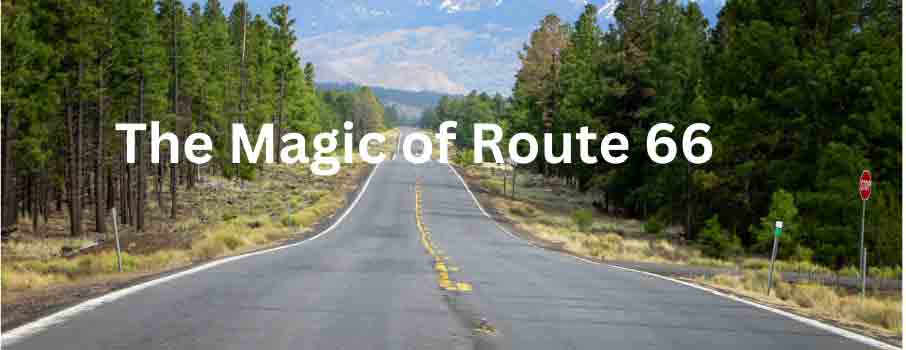Crusing Down Memory Lane
Reliving the Memories of Route 66 in the 1960’s
It was early March 1961. After spending the first five months of our married life in Washington, DC, Ron ended his military tour of duty and we were on our way “home” to California. To me, it was to be a new life in an unfamiliar place with an almost-brand-new husband.
After a detour to Florida to visit my family, we linked up with Route 66 in Texas. Even though this was 63 years ago, the memories are still very clear to me today.
At first, the big changes were at breakfast where the southern grits that I was so familiar with by growing up in the South were replaced by hash brown potatoes. Then the scenery began to change as we entered the more arid part of the country. I was excited about seeing my first “Indians” and all the national parks that I had only read about.
In New Mexico, we left the highway to see one of the ruins on the Navajo Reservation.
We were driving a 1960 Morris Mini Minor. For those of you familiar with that time in the US, foreign cars had only recently entered the US. The Mini Minor was a very small English car (one of the first front-wheel drive cars to be manufactured).
We were stopped on a dirt road out in the middle of nowhere, it seemed to me. Ron had got out of the car and I was waiting while he took pictures of the scenery. Suddenly, this tiny car was surrounded by a “huge” herd of sheep, baaing loudly as they stumbled over each other while trying to make their way up the road around our car. I had never seen sheep before and was petrified by such a large number of them at one time. My husband, Ron, and the Navajo sheepherder had a good laugh at my expense that day.
The Meteor Crater in Arizona was a memorable stop. I had read about it but was amazed at the size. At that time, you could walk down a trail into the bottom of the crater, which we did. I was from “flat country” and was scared to death of slipping as we made our way down the rocky trail. Ron kept reassuring me and taught me how to walk on steep terrain. I still did not enjoy that hike!
Just outside of Flagstaff, we stopped at Walnut Canyon National Monument. At the Visitor Center, I looked through a window and had my first view of snow-capped San Francisco Peaks. It took my breath away. I had seen the Smokey Mountains on my honeymoon but never had I seen a towering mountain topped with snow. This is a memory that will be forever etched in my mind.
Flagstaff was a small town at that time compared to today. But I was impressed with it and the area around it. The pine trees of the South, used for pulpwood, were familiar to me but they failed to compare with the “world’s largest ponderosa pine forest.” At that time, I had no idea that many years later, I would be making Flagstaff my home.
We continued on to California. Nothing really sticks out in my mind on the remainder of the trip. I was anxious to reach my new home and to visit John Steinbeck’s country that I had read so much about. We returned back over that route several times during the following years as we traveled to visit my family in Florida but nothing compares with that first trip with those first experiences.
Ron eventually entered college and became a Forester with the U.S. Forest Service. On one of the trips across country, we stopped in Flagstaff at the Forest Service office and talked to someone about living in Flagstaff.
She said, “You don’t want to live here. It’s much too windy.”
She’s partly right. It is windy. But we didn’t let that stop us. When we had the opportunity, Ron applied for and got a transfer to Flagstaff. That was 40 years ago. We loved living here so much that when his job in Flagstaff was eliminated and he was offered a transfer to Lake Tahoe, he took early retirement so that we could stay and raise our two daughters here.
As 40 years whizzed by, we’ve seen the completion of Interstate 40 and the final closure of Route 66 as a major highway.
We’ve seen communities almost die, only to be revived by caring residents, who have understood how important the history of our country, and the nostalgia associated with it, is to people. Williams, Winslow, Holbook, Kingman, Oatman, Ash Fork, Seligman are some of those towns that have succeeded in preserving the best of what was.
Flagstaff, unfortunately, has failed at that. We’ve watched it grow and become a major city in northern Arizona. Along with that growth comes some good and some bad. Northern Arizona University is no longer a small university that participated in and welcomed the participation of the local community. Instead it is a major growth producer as multi-story student housing has replaced many of the historic features that once made downtown Flagstaff special. A little of the history and the memories of Route 66 have been retained but much has fallen to modernization and the effort to become “more than just a tourist destination.”
But, for me, the memories and magic of that first trip across Route 66 and my first introduction to Flagstaff with its snow-capped San Francisco Peaks are still very much alive.

